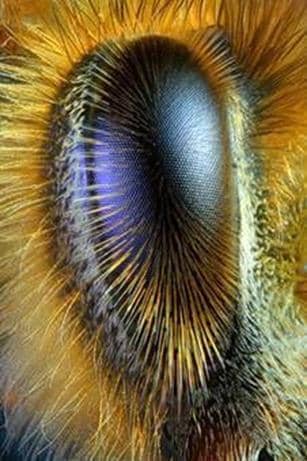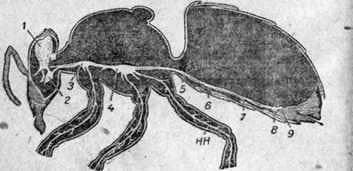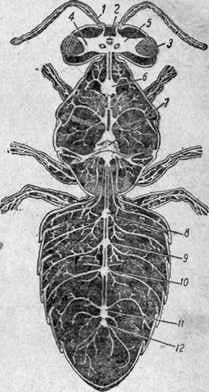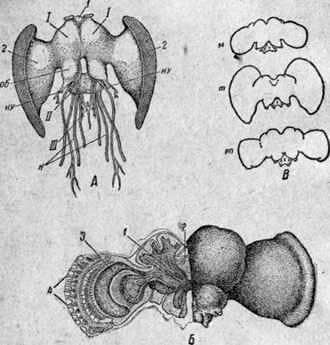
Every living organism exists in changing environmental conditions and is able to adapt to these conditions. The existence of an organism without its interaction with the external environment is impossible.
A living organism is capable of perceiving the external influences of the environment and reacting to them, in other words, it has the property of irritability.
Irritability is characteristic of all living things, but in many animals, including bees, it is especially developed.
The organs perceiving external influences (irritations) are the nervous system and the special sense organs associated with it.
Through the nervous system, all organs of the animal are coordinated in the work, as well as a rapid response to all kinds of changes that arise in the environment.
The structure of the nervous system.
The vast majority of multicellular animals develop tissue, which has a special sensitivity. This tissue, which serves to perceive stimuli and transfer excitations from one organ to another, is called a nervous tissue. It consists of nerve cells that have several processes (neurites). Some processes serve to perceive and collect stimuli, which are then carried to the body of the nerve cell; there the excitation obtained is processed and, as if reflected, in the processed form is transmitted through a different process to other nerve cells or cells of other tissues.
In lower animals, the nervous system has the simplest structure: nerve cells are scattered throughout the body, and their processes form a whole network.
A more complicated nervous system in insects appears as a series of nodules. Here already nerve cells are concentrated in groups called nerve nodes.
The processes of the nerve cells are connected to one another in complex filaments, called nerves. Nerves go to the muscles and other organs.
In some places, several nodes merge together, forming a more complex knot. It already creates a center of more intense nervous activity.
The nervous system is well developed in all insects, but it reaches its greatest development in bees and ants.
The higher the organization of the nervous system, the more difficult is the activity and behavior of the animal.
In insects, the nervous system consists of three parts: the central nervous system, peripheral and vegetative.
The central nervous system senses through the senses; the movements of the bee depend on it and the coordinated work of all its organs and parts of the body.
The vegetative nervous system is associated with the processes of nutrition, respiration, circulation, etc. The vegetative system in bees is well developed. It consists of 7-8 nerve nodes, mostly paired, lying in the head around the pharynx. They connect with each other and with the brain nerve fibers. Individual parts of this nervous system lie in the chest and abdomen. It is a system of those nerves that do not depend on the will of the animal. It is in connection with the central system.

Fig. 24. Nervous system of a working bee (side view): Brain: I – supra-pharyngeal node; 2 – hypopharyngeal node. 3-rancid neural chain: 4 pectoral nodules; 5- Abdominal nodes. DN – the nervous threads of the extremities.
The central nervous system of a bee, and other insects, consists of a chain of pairs of knots interconnected by thick nerve strings consisting of sensitive and motor nerve fibers. Nerve nodes are arranged in pairs. The larva has more nerve nodes than an adult insect. So, for example, the larva of a bee or uterus has 13 pairs of nodes: 2 pairs in the head (pair over the pharynx and under the pharynx); 3 pairs in the chest (thoracic nodes) and 8 pairs in the abdomen (abdominal knots), while the bee has only 10 pairs of nodes.

Reducing the number of nodes in adult insects is not a simplification (weakening) of the nervous system, but on the contrary, there is further centralization in the form of the fusion of certain nodes. Thus, in the bee, the nervous system becomes much more perfect and therefore more capable of performing complex functions.
Fig. 25. Nervous system of a working bee (bottom view):
1 – antennae, its nerves; 2-popit eyes; .3-complex eye; 4 – the visual lobe; 5 – the brain; 6-nodes of the abdominal neural chain.
The nerve node lying in the head of the bee is called by its position the head or supra-oropharyngeal node; by analogy with higher animals it is also called the brain or simply the brain. This node reaches a considerable size and is somewhat similar to the brain of the animal. The remaining chain of the nerve nodes extends along the median line of the ventral side (under the intestinal canal) and is called the abdominal neural circuit. The first pair of nodes of this chain is still in the head. It lies under the esophagus (and under the pharynx) and is called under the pharyngeal node. The pharyngeal node is smaller than the supraorbital node and is connected to it by nerve strings that surround the esophagus from the sides.
Individual nerve nodes retain a certain independence and their special field of action.
So, from the supra-orbital nerve node, nerves to the sensory organs: eyes, antennae, and also to the frontal nerve node (vegetative system), from which the gastrointestinal tract begins. From under the pharyngeal node, nerves go to different parts of the mouth and salivary glands. From the pectoral nodules to the legs and wings; from the abdominal nodules to the surrounding muscles, as well as to the ileum, the genital organs, the respiratory, circulatory and digestive organs.

Fig. 26. The brain of a worker’s bee:
A – general view: I – supra-pharyngeal node, II – under pharyngeal node – simple eyes; 2- visual blades of complex eyes; Obligatory shares; I am nerves. III – frontal nodule of the autonomic nervous system. B – internal structure of the brain of the worker bee: 1 – mushroom body; 2-central body; 3-optic lobe; 4 – bundles of optic nerves. B – comparative dimensions of the brain of three bees: m – uterus; m – drone of pn – worker bee.
The brain of the bee consists of the outer cell layer and the fibrous tissue located under the cell layer and constituting the inner part of the brain. Fibrous tissue forms paired formations, called mushroom-shaped bodies. Mushroom bodies of the brain are considered to be the centers of its higher nervous activity.
The brain of a working bee is well developed. Mushroom bodies in it are not only greater than those of the uterus and drone, but they are partly of a different shape, and are also more abundantly provided with nerve cells. This is in direct proportion to the fact that the conditions of life and activity of the bee – finding and collecting food, brood rearing, building a nest, protecting it and other work – are incomparably more difficult than the conditions of life and activity of the uterus and drone.
The peripheral nervous system is a collection of all nerves emanating from the nerve nodes and associated organs that perceive the stimuli of the so-called sensory organs (organs of sight, smell, touch, taste, etc.) coming from the external environment.
Sense organs.
In bees, sensory cells, specialized in a certain direction, are the receptors of certain environmental stimuli. Excitations received by the senses are transferred to the nerve centers, where they are processed and transferred to various organs of the animal, mainly muscles and glands.
Depending on the lifestyle and the environment, the animals develop sensory organs with these or other differences. Bees are very well developed eyesight and sense of smell. Well developed taste, touch and hearing.
Vision. Studies show that the lens of a simple eye, due to its strong bulge, can give a clear image only at the closest distance, for example, when working in a hive and in flower haloes.
The weak convexity of the lenses of the complex eyes indicates that a distinct image can be obtained only when the object under consideration is at a considerable distance.
Consequently, complex eyes serve to see afar, when flying a bee. In addition, with the help of complex eyes, the bee distinguishes light from different areas of the sky, which allows it to better navigate during flight activity. The ability to distinguish colors depends on the structure and perfection of the eyes of the bee.
By staging honey or syrup for bees on squares of different colors, it was proved that bees distinguish colors. Only they see colors (spectrum) differently than we do. So, they distinguish blue, white and yellow colors unconditionally and clearly distinguish the blue color. The red and corresponding intensity of the gray bee’s color seem to be the same. Bees have the ability to distinguish between so-called ultraviolet rays, invisible people. Therefore, hives, painted with white paint of different composition, often easily differ by bees.
The sense of smell. Experiments show that bees have such a developed sense of smell that they understand a number of different smells, choosing from them the smell they need. Their sense of smell is incomparably more acute than that of a person. For example, bees can easily find the source of nectar by smell: they easily find every spilled drop of honey in a bite-free time, try to penetrate into the room where honey is stored, etc. Bees of one beehive can distinguish their bees from the bees of another hive. Watchdog bees near the tap are touching, as if sniffing their mustache bees entering beetles and instantly recognize strangers. The bee, devoid of tendrils, loses the ability to find food and build honeycombs correctly. Organs of smell, bees are membranous or olfactory plates located near the bee on the upper side of the antennae, and in the drone around the whole antenna. On the surface of the antenna there are a lot of so-called pore plates with nerve endings that perceive odors. Each uterus has 1868 in the uterus, 2218 in the working bee, and 2601 in the drone most.
Taste.
The taste of the bees is also well developed. Bees are willing to take sweetened water if 4-5% of sugar is dissolved in it, at the same time they do not want to take honey or sugar syrup if you add more than 3% of salt to it, for example, a solution of saccharin is not taken from the bee, but the solution of quinine with sugar syrup is taken. The organ of taste is in the mouth of the bee and its appendages (at the base of the tongue).
Touch.
The organs of sense of touch are hollow chitinous hairs, into which the ends of the nerves enter. Touching such hairs causes irritation of nerve endings. In bees, these organs are located throughout the body, on the tentacles of the mouth and near the sting, but especially abundantly on the antennae.
Hearing.
It is known that bees produce different sounds and understand them. Observations have established that bees have good hearing. If you approach the hive with a noise, you can see how the guard bees turned to the side of the noise. It is enough to knock on the hive lightly, as the bees will respond in unison.
The family of bees publishes so-called “plaintive” sounds or “bezmokatichny” hum with loss of the uterus; “contented” hum while finding the uterus; “cheerful” in swarming, etc. However, here it is necessary to emphasize the conventionality of these names. Also known as “roll call” (“singing”) of queens, when the sound of one uterus is immediately responded to by others; then they hear, that is, they have organs that perceive sounds of different heights.
Now it is revealed that bees can produce and perceive sounds of very high tone (the so-called ultrasounds) that are not audible to us.
It is believed that sound waves (vibrations of air particles) are perceived by the numerous hairs present on the body of the bee. Nerve endings approach them, which transmit the corresponding stimuli to the central nervous system.
Reflexes of bees.
Having a well developed central and peripheral nervous system, the bee is able to perceive, to a large extent, the irritations of the continuously changing external environment and to react to them.
Let’s consider it on examples. If the pin of a sitting bee is gently touched with a pin, then it can respond to this irritation by pushing the leg. There is it as follows. The nerve endings of the bee’s leg received irritation, which was transmitted along the nerve to the brain center, the nerve cells of the abdominal neural chain. There irritation was reworked and, as if reflected, passed on to another nerve to the muscles of the same leg. The muscles of the leg, having received a processed irritation, responded to it with a contraction, and the leg moved away.
Such responses of the body to stimulation of the endings of sensory nerves, which takes place with the participation of two nerve conductors and the brain center, are called reflexes. Reflexes in the bee, as in many other animals, very much. They underlie the regulatory activity of the nervous system. The great Russian physiologist IP Pavlov pointed out that “In the life of a complex organism, the reflex is the most essential and most frequent nervous phenomenon, with the help of which the correct and precise ratio of the parts of the organism to each other and the ratio of the whole organism to the surrounding conditions are established. irritation of the peripheral endings of the centripetal nerves. This ends imbued all the organs and all their tissues.
Reflexes are simple and complex, depending on which parts of the central nervous system participate in them (lower or higher).
In the example of the reflex of the bee described above, the nerve nodes of the abdominal neural circuit, which is the lower section of the central nervous system in the bee, took part, hence this is a simple reflex. But if it responds differently to irritation of the sensitive nerve endings of the bee, it is more difficult, for example, to fly away or sting, then such responses of the organism to external stimuli are called complex reflexes, since higher parts of the central nervous system participate in them. which carry out consistency in the work of many organs of bees and other insects.
Many reflexes of the bee are very complex, for example, feeding brood, getting food, building honeycombs, etc.
Long-standing experiments of IP Pavlov have shown that animals have a dual kind of reflexes. Some reflexes are congenital, permanent, equally characteristic of all organisms of this species. They do not require their special development by the body: the animal is born having these reflexes. IP Pavlov called them their unconditional reflexes, or instincts.
Bees distinguish instincts: food, defensive and sexual. In addition, they developed the instinct of caring for the offspring (brood rearing) and the construction of honeycombs. All of them are present in every bee and are congenital, or complex, unconditioned reflexes. A young bee that has just emerged from the cell extends the proboscis to other bees, and they give it food. The bee, who has seen the flower for the first time, looks for nectar in it and collects pollen, while making the most complicated coordinated movements with legs, wings, mouth parts, although nobody taught it to her.
Not all instincts manifest simultaneously. The manifestation of these or other reflexes mainly depends on the environment (environmental conditions) and is partly related to the age of the bees.
Instincts form the basis for the behavior of the bee and the bee family. It is customary to call behavior the entire body of body movements, the work of all its organs and glands, aimed at protecting its existence, on defense from danger, on reproduction and rearing offspring.
The instincts of bees are highly developed, and most of them are very complex. So, for example, the instinct of waxing and building honeycombs in bees is best manifested only when 5 factors are affected: the presence of a fetal uterus in the family, the availability of a free space for detaching the honeycomb, a sufficient number of young bees, an abundance of feed, and a normal nest temperature. The construction of honeycombs also depends on a number of reasons: in some conditions honeycombs with bee cells are built, in others – with drone cells, in the third – simultaneously with the construction of drone honeycombs, the bee cells are reworked into drone cells, etc.
With the manifestation of some instincts of bees, it is often observed that the reaction of bees to the effect of environmental conditions is not simultaneous, but a delimitation in time, and consists of a chain of successive actions. So, the instinct of reproduction of bees swarming manifests itself in the abundance of bees in the family, especially young ones, not loaded with work, crowdedness and “stuffiness” in the nest and having a bribe. When this instinct is manifested, bees build up bowls for the withdrawal of queens, the number of drone brood increases, then the eggs are laid in the bowls, the queen’s mothers are set up and the larvae are fed; finally comes out the first swarm, followed by the second, and so on.
If, during the manifestation of the instinct, the conditions of the environment change, for example, bribes stop, the chain of instinctive phenomena of reproduction is interrupted, and in the event of the resumption of the violated condition (bribe), the whole chain begins again. In addition to unconditioned reflexes (instincts), animals also have other reflexes that are not congenital, but are acquired throughout the life of the animal. These reflexes were first studied by IP Pavlov and called them conditioned reflexes. The conditioned reflexes of the animal are created as a result of his personal experience. Newborn animals do not. Conditional reflexes are temporary, unstable. They are formed on the basis of unconditioned reflexes and are found mostly in highly organized animals, in so-called vertebrates, but to a certain extent there are also bees and other insects.
On the reflexes of animals, many examples can be cited from the experiments of I. P. Pavlov. If, for example, a puppy fed only with milk gives a piece of meat, then saliva will start to appear only after this meat enters the mouth and irritates the taste buds; this irritation is transmitted to the brain, and after processing there, it will reach the salivary glands. This response of the body to stimulation is an example of an unconditioned reflex. But with the subsequent feeding of the puppy, his saliva starts to be released earlier than a piece of meat gets into the mouth: the salivation is caused by the type of meat, its smell, etc. Here we have a conditioned reflex.
The second example. If before a feeding of an animal, for example, a dog, a bell rings, and this will happen several times, soon only the sound of the bell will cause a copious salivation of the animal. On the basis of a food, unconditioned reflex, a conditioned reflex is developed, that is, a temporary connection of the external agent with the response of the organism to it. Conditional reflexes are fickle. They can increase the more, the more times there is a coincidence of external irritation with food. But if the conditioned reflex is not further reinforced, then it fades and disappears.
Conditional reflexes correspond to what are usually called habits, or skills. All animals with a normal nervous system are able to act to a certain extent according to environmental conditions and at any time to use their experience and habits. So, if a bee that has found food near the hive, typing it into a crab, will bring it to the beehive, then it will use this experience and fly there again, and will fly until the food is there. If the food is withdrawn or its allocation by flowers ceases, then the developed skill (conditioned reflex) will gradually fade. The bee, having made several more in vain flights and not having received the reinforcement of the conditioned conditioned reflex unconditionally (food), eventually ceases to fly there.
Not all bees in the family have conditioned reflexes in the same way. Young, non-flying bees perform their inherent work mainly instinctively. In flying bees, in addition to unconditioned reflexes, conditioned reflexes are also developed, related to their flying activity, finding sources of bribes and finding their hive.
Some conditioned reflexes in bees are especially developed. The bee, once taking food in a certain place, will not only arrive there again, but, bringing the food to the hive, in its own way will inform many other bees of direction and distance from the source of the bribe, after which many other flying bees easily find the feed brought the first bee.
Conditional reflexes, repeating themselves in generations, can be transformed into unconditional, innate.
On the other hand, even innate reflexes, instincts, can to a large extent, depending on the conditions, either develop or fade. So, the construction of honeycombs is caused by an innate reflex, instinct. If bees for many generations will create good conditions for voskonstroitelstva (a good food base, providing abundant and continuous bribes, strong families, the presence of an empty place in the hive, etc.), then the instinct of waxing and building honeycombs will develop. If such conditions for a number of generations are not provided to the bees, then this instinct will fade.
The task of beekeepers is to develop in every possible way the useful instincts and conditioned reflexes of bees, creating the most complete conditions for their manifestation with the aim of improving the quality of bees and increasing their productivity.
The method used in the practice of bee-dusting, called “bee training,” is based on the production of conditioned reflexes in bees for the smell of food. The essence of this technique is that after giving feed (usually in a hive) with the smell of certain flowers, some part of flying bees flies out of the hive and looks for nectar in the flowers of plants of this species, which produces additional pollination and promotes an increase in the yield of these plants. However, this most valuable technique requires further development and improvement, because when feeding a beehive in a beehive, a conditioned reflex is developed not only on the smell of food, but also on its location, appearance, appearance time, etc. Therefore, in practice introduced and other, more advanced methods of “bee training”. For more details, see “
Practice shows that “bee training” is especially effective when the apiary is most closely transported to the sites where the polluted plants grow, and when these plants are the most secreting nectar. Therefore, it is especially important that the areas of honey plants pollinated by bees are cultivated according to all the rules of advanced agrotechnics, which promotes the best development of plants and, at the same time, the best nectar release.
Цвета пчелиного улья. Дезинфекция пчелиных рамок.
Biology of the bee family